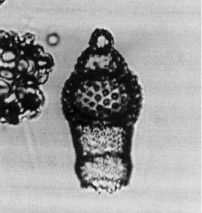 Stichocorys
wolffii Haeckel
Stichocorys
wolffii Haeckel Stichocorys
wolffii Haeckel
Stichocorys
wolffii HaeckelStichocorys wolffii Haeckel, 1887, p.1479, pl.80, fig.10; Riedel, 1957, p.92, pl.4, figs.6-7
Stichocorys baerii Haeckel, 1887, p.1479, pl.80, fig.8
Stichocorys mulleri Haeckel, 1887, p.1480
Shell with four or more segments (usually 5 or 6), of which the cephalis, thorax and abdomen form an upper conical portion sharply differentiated from the subcylindrical lower portion. Shell surface usually rough or thorny in upper portion, smooth post-abdominally. Cephalis spherical, usually poreless, bearing a sharp conical apical horn of approximately the same length or shorter. Thorax hemispherical, with most of the pores (irregularly or approximately hexagonally arranged) secondarily closed with siliceous lamellae; pores rarely with a tendency toward longitudinal alignment, with rows separated by longitudinal ridges. Abdomen inflated annular, with round pores (sometimes double-contoured) approximately hexagonally arranged, often with apparent longitudinal alignment, of approximately the same width as the intervening bars. Fourth and subsequent segments narrower than widest part of abdomen, thinner-walled than first three segments, with pores of proximal one or two segments often tending to longitudinal alignment with intervening longitudinal ridges, and pores of distal segments irregular in size, shape and arrangement (Riedel, 1957).
Length of first three segments 85-110 µm; breadth of abdomen 65-100 µm, of fourth segment 55-75 µm (Riedel, 1957).
Under this name we record all specimens of Stichocorys in which the thorax is practically poreless (with no more than half a dozen pores on the visible half of that segment). In many specimens the fourth segment has rather irregular longitudinal ridges, but this is not a required characteristic for the species (Riedel and Sanfilippo, 1978a).
S. wolffii is distinguished from the co-occurring S. delmontensis by its practically poreless thorax - only specimens with a total of twelve or less thoracic pores are admitted. A commonly occurring feature, but not required for identification, is the presence of rather irregular longitudinal ridges on the fourth segment.
In the later part of its range, where the skeletons are small and sparsely porous, some co-occurring forms do not have a wider, conical upper part of the shell and a narrower, terminal cylindrical part. Such specimens are not included in this species.
We suspect that S. wolffii is not a good "biological" species, but might rather be simply a morphological variant of S. delmontensis. However, it is retained because of its stratigraphic utility (Sanfilippo et al., 1985).
Through the greatest part of its range, the most variable features are the breadth of the third segment (ranging from 65 to 100 µm), and the degree of distinctness of the segments forming the narrower, post-abdominal part of the skeleton. In the latest part of its range, the test is generally smaller (breadth of third segment 50-80 µm; length of first three segments (excluding horn) 75-100 µm), and its wall tends to become almost completely poreless.
One complication in the stratigraphic use of this species is the fact that, at least once or twice during its range, it declined in abundance by about two orders of magnitude (Westberg and Riedel, 1978, p.13, text-fig.9) (Sanfilippo et al., 1985).
S. wolffii is found in tropical late early to middle Miocene assemblages, and a few specimens have been recorded in the Mediterranean. Its morphotypic first appearance defines the base of the Stichocorys wolffii. Its morphotypic last appearance is approximately synchronous with the base of the Diartus petterssoni Zone.
Additional illustrations can be found in Riedel and Sanfilippo, 1971, pl.2E, figs.8-9; Riedel and Sanfilippo, 1978a, pl.1, fig.3, pl.9, fig.12.
For a long period during the early part of its range, this species is accompanied by specimens of Stichocorys delmontensis identical in all respects in possessing a more porous thorax. Only toward the end of its range does it diverge substantially from the accompanying S. delmontensis; it is smaller, and other segments in addition to the thorax tend to be poreless... In many of the specimens of S. wolffii near the top of its range, segmental divisions beyond the third tend to be lost (Riedel and Sanfilippo, 1978a).
DSDP Site 289 contains a segment throughout which S. wolffii predominates numerically over S. delmontensis, this segment being preceded and succeeded by segments in which S. delmontensis is predominant. The most characteristic S. wolffii morphotype is restricted to the S. wolffii dominated segment. The levels of population change are comparatively easily recognizable datums at Site 289. However, the observed morphologic gradation between S. wolffii and S. delmontensis morphotypes, and the reversible dominance of the former might suggest that "S. wolffii" is no more than a dimorph of S. delmontensis, its abundance being determined by local environmental factors (Holdsworth, 1975, p.531).